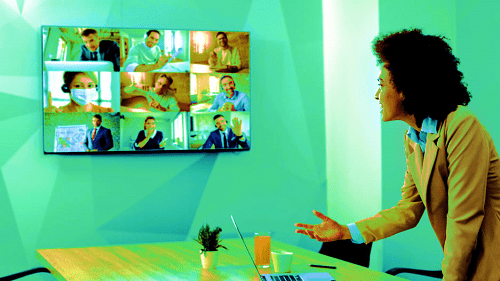
4.2.21 – FC
Despite new norms around flexible work environments, inclusive work spaces and habits still deserve consideration.
Businesses across the globe have come a long way in embracing the digital office over the past year, since work-from-home became the standard for nonessential companies. Even before the pandemic, I championed the concept of the “modern” working environment and embraced the hybrid office (half in-office, half remote).
In the new normal, more offices will need to move to a hybrid model, not just to cut down on the number of people in a given space at one time, but because we’re all experiencing the perks of remote work, which is something employees across the board will expect after the threat of the pandemic subsides.
With vaccines becoming more readily available across the country, the prospect of returning to the office is becoming a reality. Many people are anxious and ready to get back into the office in some shape or form. However, we must do it responsibly. We must ensure that we empower workers as they return, as well as those who continue working remotely indefinitely.
STRONGER WI-FI AND MORE DIGITAL STORAGE SPACE
It’s a familiar routine: We’re in the middle of making a great point in a team meeting on a video call when someone says, “Oh by the way, you’re frozen,” or “I think you lost connection.” Despite this uncomfortable circumstance, video calls are likely here to stay; connectivity will be crucial to ensure high-quality video calls can occur for internal and external meetings.
Internet companies stepped up at the beginning of the pandemic, particularly for students forced into remote learning environments. Operations teams need to work hand in hand to make sure their current packages will be able to support the office’s new needs, and if not, find alternative packages that will power their teams.
Businesses such as Google Drive and Dropbox were already touting cloud technology. Now, storage and asset management will continue being important investments, even when our teams return to the office.
While many were already familiar with these systems and leveraging them on a day-to-day basis, not everyone will be in the office at the same time, due to the hybrid workplace and more flexible work conditions. After a year of working remotely, our cloud organizational drives have seen more files uploaded than ever—and this trend is likely to continue.
These investments will create a solid infrastructure for teams to work in the office, at home, or anywhere.
ADJUSTING THE PREVIOUS STATE OF WORKFLOWS
While digital workflows have been top of mind, now that the return to office is more imminent, our in-office workflows will need a reboot. As a key priority for most offices and businesses, operations teams will look to upgrade current spaces, making them safe and effective for the hybrid workforce.
After a year-plus of remote work, operations teams will be tasked with reconfiguring office layouts: where desks are located, making sure employees have enough room to feel comfortable returning to the office, looking at office soft spaces, and providing team members with spaces to connect safely.
With hybrid work, offices will need to bring in some of the aspects of remote work that employees now appreciate and expect. These include embracing some of the benefits of working from home such as bringing in more standing desks and incorporating more flexible spaces for phone calls and personal matters, while fostering focus.
MORE COLLABORATIVE AND EVOLVED CONFERENCE ROOMS
Conference rooms will experience a major makeover. While the future of the workforce is hybrid, conference rooms will still play a larger role than they did in the pre-pandemic office.
The reality is that not everyone will be in the office all at once, owing to safety reasons, but also due to the fact that people now want a more flexible lifestyle.
Of course, hybrid teams will still need meetings and group calls to feel inclusive and, in turn, productive. Conference rooms will need to be laid out differently, just like our common spaces and desks, to ensure that teams have space between each other on calls. This might include having fewer seats at a larger table, or having one larger table and smaller tables in the room too.
This will also mean our video solutions will need to accommodate these new structures. Conference rooms should be equipped with high-quality video cameras, microphones, and speakers to provide accurate and seamless tech experiences to those taking meetings in and out of the office. These solutions will increase the level of productivity and efficiency by eliminating technical issues; they will also enhance the quality of experience for employees, making them still feel included, even when working remotely.
The modern workplace is still something we’re creating, finding solutions that will make work-from-anywhere as effortless as possible. But operations teams, office managers, and HR will be the driving force behind this shift, powering the hybrid workplace.
Frank Weishaupt is the CEO of Owl Labs, a collaborative tech company revolutionizing how organizations of all sizes communicate. Owl Labs is a pioneer in the work-from-anywhere movement, through its work developing the award-winning Meeting Owl Pro and its annual State of Remote Work report.
